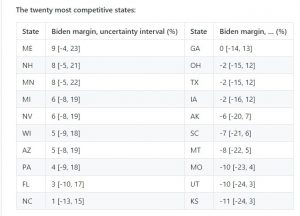The following article by Ruy Teixeira, author of The Optimistic Leftist and other works of political analysis, is cross-posted from his blog:
Is it that the left just can’t take “yes” for an answer?
One has to wonder given the continued lack of enthusiasm for Biden in certain quarters. This is strange given that the left presumably stands for, well, left policies. And Biden’s got ’em by the bushel, as Matt Yglesias lays out in an excellent, detailed article on Vox.
1. A big minimum wage increase
2. Free college for most
3. Enhancing the Affordable Care Act
4. Dramatic transformation of federal housing policy
5. A huge financial boost to schools with low-income students
6. A labor-friendly climate agenda
7. Major commitments on union organizing
8. Back to the future on immigration
As Yglesias points out, this adds up to a lot. And how far Biden gets with it if elected will have less to do with any lack of ambition and more to do with the Congress he has to work with. The logical course, therefore is to back Biden to the hilt, work hard to deliver him the Congress he’ll need and be prepared to put pressure on him to stick with the commitments he has already made.
Or is it really the case that the left can’t take “yes” for answer? Between now and November, we’ll find out.
“Biden is a mainstream Democrat, and as the Democratic Party has grown broadly more progressive in recent years, he is now running on arguably the most progressive policy platform of any Democratic nominee in history.
It’s a detailed and aggressive agenda that includes doubling the minimum wage and tripling funding for schools with low-income students. He is proposing the most sweeping overhaul of immigration policy in a generation, the biggest pro-union push in three generations, and the most ambitious environmental agenda of all time.
If Democrats take back the Senate in the fall, Biden could make his agenda happen. A primary is about airing disagreements, but legislating is about building consensus. The Democratic Party largely agrees on a suite of big policy changes that would improve the lives of millions of Americans in meaningful ways. Biden has detailed, considered plans to put much of this agenda in place. But getting these plans done will be driven much more by the outcome of the congressional elections than his questioned ambition.”




